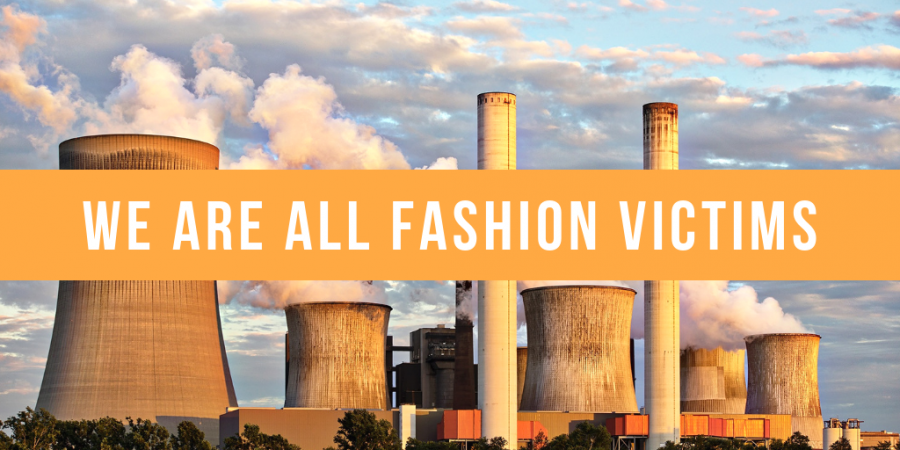The fashion industry has a devastating impact on people and the environment. Graphics credit: Sofie Salcedo
What’s wrong with fast fashion?
December 20, 2018

Cheap clothing may seem attractive to the buyer on a budget, but the “invisible price tag” attached to items from stores like Shein and Forever 21 contains additional human and environmental expenses that we often fail to realize.
Fast fashion refers to clothing from such brands that is made cheaply and quickly. In recent years, the traditional “seasons” model consisting of four annual collections has been thrown out in favor of near-weekly “micro-collections.” When one item runs out of stock, it is simply replaced by a new one cultivating a “day in, day out” mentality, encouraging us to buy more clothes more often in order to stay on trend. The average U.S. citizen throws away 70 pounds of clothing each year, all of it ending up in landfills. This is extremely detrimental, not only to our credit scores, but to the environment.
According to PureEarth, the textile industry is the tenth most polluting industry in the world as of 2018. On average, over seven pounds of carbon dioxide are emitted per single pound of fabric produced. Not only are we buying all of the clothes that is killing our environment, but most of us aren’t even using them! According to one study, the average American did not wear 82% of their wardrobe last year. In production of these clothes, toxic runoff from dyes spills into oceans and rivers, carbon dioxide is pumped into the atmosphere and leftover materials are sent to landfills and waste plants. All of this pollution is produced for a shirt we wear once before trashing.
Aside from the horrifying environmental consequences, fast fashion labor practices are equally disturbing. Though child labor is outlawed in most countries, the International Labor Organization estimates that approximately 170 million children are involved in illegal labor practices around the world, many in the fashion industry. Even adults suffer in the unsafe and unjust working conditions forced upon them by corporations like H&M. A great percentage of the workers are women and have reported terrible abuse at the hands of supervisors. (You can read more on this here.) In Thailand, these “sweatshop” workers earn an average of $33 per month, when the monthly cost of living is $60. They work for long hours without breaks and are denied from forming unions to protect their rights; these are only the laborers who are paid for their work. In these factories, pay isn’t always a given. Two years ago, Zara was exposed for utilizing Syrian refugees as slave labor in Turkey. In supporting fast fashion, you are by proxy supporting all of the human rights atrocities that come with it.
But what can we do to help? For starters, we can buy less. In exercising greater self-control and not buying every item we think is trendy, we can reduce our individual carbon footprints and inspire these companies to restrain their production practices. We can also boycott companies like Shein, Romwe, Forever 21, Charlotte Russe, H&M, Zara and ASOS that abuse their workers and the environment, and instead buy from more sustainable brands like Everlane and Pact. While it can be more expensive to buy from free-trade companies, there is an even more feasible and affordable solution right in your community: secondhand shopping. It’s no secret that “thrifting” has become increasingly popular in recent years and for good reason! Thrift shopping is a fantastic way to buy unique, reasonably priced clothing and reduce our negative impact on the world. Additionally, it’s more possible than ever with online alternatives like thredUP and Depop. Lastly, we can take our knowledge and inform others. When our friends head to the mall, we can advise them not to support certain organizations and even suggest that they join us at a local resale shop instead. (Read more about Roswell’s top secondhand stores here. < will link to my “best secondhand shopping” article)
In conclusion, fast fashion is an unnecessary risk to our earth and its inhabitants. From toxic runoff to the abuse of workers, these companies’ practices serve to benefit no one but the top executives. They prey on our compulsion to stay on trend and it is time that we take a stand. We need to assess our individual impacts on the environment through our fashion practices and hopefully make a change for the better.
Here is a short, educational video by HuffPost with more information about the effects of fast fashion.
For more information check out the links below:
https://www.worldatlas.com/articles/the-top-10-polluting-industries-in-the-world.html
https://oecotextiles.wordpress.com/category/co2-emissions-in-textile-industry/
https://labs.theguardian.com/unicef-child-labour/
https://www.globalcitizen.org/en/content/hm-gap-factory-abuse-fast-fashion-workers/
